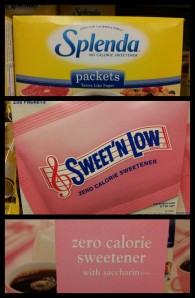Posts Tagged artificial
Artificial Sweeteners – Aspartame (Equal, Sweet ‘N Low)
Posted by Jesse Thornton in Nutrition and Health on December 9, 2014
 In a continuation of my coverage on artificial sweeteners, this post will be dedicated to one of the most controversial of them all: aspartame. That’s because aspartame has been blamed for causing cancer and attributed to many other afflictions, which is evident in this chain email that circulated in 1998 during the early days of the internet. In particular I remember the stories growing up, before I could even pronounce the word, that claimed aspartame causes cancer, and like many people, I automatically believed it was true. I’ve dug through the scientific literature, there was a ton of it to look through…part of the reason it took so long for me to write this article. Not surprisingly I’ve found that most of the claims are unsubstantiated by evidence, despite the fact that many of these studies are 20-30 years old – something that I do take issue with. I did find some more recent compelling research, backed by a plausible mechanism on the potential neurotoxic effects of long-term aspartame consumption. Those studies used large doses of aspartame, but were within the FDA acceptable daily intake limit, and I would urge you to read on for more context. Aspartame may also have an affect on metabolic parameters related to diabetes and obesity, as well as composition of gut bacteria. The evidence is conflicting, however, and many of these same issues are brought up surrounding other artificial sweeteners as well. Read the rest of this entry »
In a continuation of my coverage on artificial sweeteners, this post will be dedicated to one of the most controversial of them all: aspartame. That’s because aspartame has been blamed for causing cancer and attributed to many other afflictions, which is evident in this chain email that circulated in 1998 during the early days of the internet. In particular I remember the stories growing up, before I could even pronounce the word, that claimed aspartame causes cancer, and like many people, I automatically believed it was true. I’ve dug through the scientific literature, there was a ton of it to look through…part of the reason it took so long for me to write this article. Not surprisingly I’ve found that most of the claims are unsubstantiated by evidence, despite the fact that many of these studies are 20-30 years old – something that I do take issue with. I did find some more recent compelling research, backed by a plausible mechanism on the potential neurotoxic effects of long-term aspartame consumption. Those studies used large doses of aspartame, but were within the FDA acceptable daily intake limit, and I would urge you to read on for more context. Aspartame may also have an affect on metabolic parameters related to diabetes and obesity, as well as composition of gut bacteria. The evidence is conflicting, however, and many of these same issues are brought up surrounding other artificial sweeteners as well. Read the rest of this entry »
Artificial Sweeteners – Sucralose (Splenda)
Posted by Jesse Thornton in Nutrition and Health on August 11, 2014
 Artificial sweeteners are sugar substitutes that provide no nutritional value and are made by chemical processes, rather than naturally occurring in the environment. As such, there’s always a lot of negative attention directed toward artificial sweeteners and indeed, anything labeled as “artificial.” I’ve decided to do a series of articles on artificial sweeteners to find out what claims are true and what isn’t, instead of doing one article with a bullet point list. There’s just too much information to condense everything into one article and I like to include as much context as possible because most things are not black and white issues, and this topic is no exception. So the first article in this series will concentrate on what science currently has to say about the most widely used artificial sweetener on the market: sucralose.
Artificial sweeteners are sugar substitutes that provide no nutritional value and are made by chemical processes, rather than naturally occurring in the environment. As such, there’s always a lot of negative attention directed toward artificial sweeteners and indeed, anything labeled as “artificial.” I’ve decided to do a series of articles on artificial sweeteners to find out what claims are true and what isn’t, instead of doing one article with a bullet point list. There’s just too much information to condense everything into one article and I like to include as much context as possible because most things are not black and white issues, and this topic is no exception. So the first article in this series will concentrate on what science currently has to say about the most widely used artificial sweetener on the market: sucralose.
Sucralose (Splenda)
Surcalose, best known as the key ingredient in Splenda, is a non-nutritive sweetener 600 times sweeter than sugar by weight. The molecule itself is produced by a series of chemical reactions, starting with sugar as a base, then, stripping away 3 hydroxyl groups from the original sugar molecule and replacing them with chlorine atoms. The added chlorine atoms make sucralose sweeter than sugar while also preventing it from being metabolized by the body. This means that sucralose is not used as an energy source by the body and is simply eliminated as a waste product. Read the rest of this entry »
